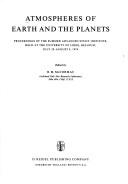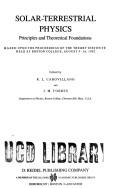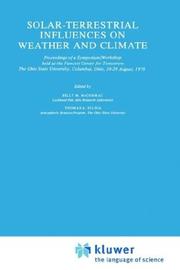| Listing 1 - 10 of 32 | << page >> |
Sort by
|
Periodical
Abstract | Keywords | Export | Availability | Bookmark
 Loading...
Loading...Choose an application
- Reference Manager
- EndNote
- RefWorks (Direct export to RefWorks)
Space environment --- Space environment. --- solar physics --- meteorology --- aeronomy --- electrical engineering --- climatology --- mathematics --- Meteorology. Climatology
Periodical
Abstract | Keywords | Export | Availability | Bookmark
 Loading...
Loading...Choose an application
- Reference Manager
- EndNote
- RefWorks (Direct export to RefWorks)
Space sciences --- Atmosphere, Upper --- Sciences spatiales --- Haute atmosphère --- Périodiques. --- Aeronomy --- Upper atmosphere --- Atmosphere

ISBN: 9027705755 9401018014 9401017999 9789027705754 Year: 1974 Volume: 51 Publisher: Dordrecht Reidel
Abstract | Keywords | Export | Availability | Bookmark
 Loading...
Loading...Choose an application
- Reference Manager
- EndNote
- RefWorks (Direct export to RefWorks)
Astrophysics --- Geophysics --- Solar system --- Atmospheres --- -Planets --- -Aeronomy --- -Astronomie. Astrofysica. Ruimteonderzoek. Geodesie --- Atmosphere --- Atmosphere, Upper --- Planets --- Congresses --- Congresses. --- 52 --- Atmospheres&delete& --- Astronomie. Astrofysica. Ruimteonderzoek. Geodesie --- Aeronomy --- Atmosphere - Congresses --- Atmosphere, Upper - Congresses --- Planets - Atmospheres - Congresses
Dissertation

Year: 2019 Publisher: Liège Université de Liège (ULiège)
Abstract | Keywords | Export | Availability | Bookmark
 Loading...
Loading...Choose an application
- Reference Manager
- EndNote
- RefWorks (Direct export to RefWorks)
Modeling atmospheric escape is an important process, which significant attention has been given to the last decades because it is necessary to understand characteristics of the different layers of an atmosphere, such as the thermosphere, the ionosphere or the exosphere. Historically, simulations of atmospheric escape were done using analytic models, for example Jeans theory or hydrodynamic escape. However, these techniques fail to correctly simulate the higher altitude layers where particles' density is low and their velocity distribution begin to depart from a Maxwellian distribution so that the atmosphere can no longer be described as a fuid. More recently, new ways of considering escape have arisen and now simulations are commonly performed using a kinetic method called the direct simulation Monte-Carlo (DSMC), which better describes the transition from collisional to collisionless regions of the atmosphere. For the present work, we have considered a different kinetic technique, called the Discrete Velocity Method (DVM), that has not been as often used to address atmospheric escape problems. We have reproduced the DVM model of Merryfield and Shizgal (1994) and applied it to an idealised Earth-like neutral single component atmosphere. DVM is shown to be an effective technique and also time saving with respect to its statistical equivalent DSMC, when simulating atmospheric escape. In this manuscript, we first present a relevant scientific background on general atmospheric escape processes. Then, we explain the theory behind Boltzmann equation, the central equation to be solved. Finally we present a short section on numerical computation. Then, we detail how we have built the complete model based on a step by step development where we go form a one-dimensional to a complete four-dimensional problem. Along this process, we investigate different combinations of finite difference schemes and features used to solve the Boltzmann equation and discuss why we decided to keep working with some particular combinations for the complete model. Finally, we present the results from a series of simulations aimed at investigating a new lower boundary condition. Then, we compare them to fluid-Jeans and DSMC results. By doing so, we wish to qualify the technique and emphasize the consistency and relevance of DVM as well as the computation time saving it allows. The model we developed simulates a neutral hard sphere single component atmosphere. It is the basic form of the problem and it could be expanded by considering, for example, variable hard spheres, multiple components, external heating, photochemistry or taking into account ions and electrons. Durant les quelques dernières décennies, une certaine attention a été portée sur la modélisation de l'échappement atmosphérique. C’est en effet un procédé important car il permet de mieux comprendre les caractéristiques des différentes couches dans une atmosphère, telles que la thermosphère, l'ionosphère ou encore l'exosphère. Historiquement, les simulations de l'échappement atmosphérique étaient réalisées à l'aide de modèles analytiques, comme la théorie de Jeans ou bien des modèles d'échappement hydrodynamique. Cependant, ces techniques ne simulent pas correctement les plus hautes couches atmosphériques là où les densités de particules sont basses et divergent d'une distribution maxwellienne, de telle sorte que l'atmosphère ne peut plus être décrite comme un fluide. Plus récemment, de nouvelles façons de faire ont été développées dans le cadre de l'échappement atmosphérique. Désormais, les simulations sont exécutées tout en utilisant une méthode kinétique appelée simulation directe de Monte-Carlo (DSMC). Cette technique permet de mieux décrire la transition entre les régions atmosphériques dominées par les collisions entre les particules et les régions où les collisions sont absentes. Dans ce présent travail, nous avons considéré une technique kinétique appelée la méthode de vitesse discrète (DVM), qui n'a pas souvent été sollicitée en modélisation de problèmes liés à l'échappement atmosphérique. Nous avons reproduit le modèle de DVM de Merryfield et Shizgal (1994) et nous l'avons appliqué à une atmosphère terrestre neutre idéalisée et composée d'un type de particule. La DVM est démontrée efficace et apporte un gain de temps par rapport à la DSMC, son équivalent statistique, lorsqu'il est question de simulation d'échappement atmosphérique. Dans cet écrit, nous commençons par un rappel théorique concernant les concepts généraux des procédés d'échappement atmosphérique. Ensuite, nous expliquons la théorie utilisée dans l'équation de Boltzmann, qui est l'équation centrale du problème. Enfin, nous parlons brièvement d'un concept de calcul numérique utilisé. Par la suite, nous détaillons la façon dont nous avons construit le modèle complet, basé sur un développement par étape où nous partons du problème à une seule dimension, pour arriver au problème complet à quatre dimensions. Au cours de ce procédé, nous avons investigué sur différentes combinaisons de schémas de différences finies ainsi que sur des astuces pour résoudre l'équation de Boltzmann. Nous y discutons également des diverses raisons de notre choix de continuer à travailler avec certaines combinaisons pour le modèle complet. Nous expliquons aussi comment nous avons résolu le problème en appliquant des schémas d'intégration spécifiques. Finalement, nous présentons des résultats d'une série de simulations ayant pour but d'investiguer sur l'utilisation d'une nouvelle condition de bord inférieure et ensuite nous comparons ceux-ci aux résultats de simulations fluid-Jeans et DSMC. En faisant ces comparaisons, nous voulons qualifier la technique de DVM et mettre l'accent sur sa pertinence ainsi que sur le gain de temps de calcul qu'elle permet d'atteindre. Le modèle développé simule une atmosphère neutre, composée d'un seul type de particules sphères dures. Il est la version de base du problème d'échappement atmosphérique et pourrait être étendu en considérant, par exemple, des particules sphères dures variables, une composition de plusieurs types de particules, un échauffement externe de l'atmosphère considérée, la photochimie ou bien en prenant en compte les ions et électrons.
Periodical
Abstract | Keywords | Export | Availability | Bookmark
 Loading...
Loading...Choose an application
- Reference Manager
- EndNote
- RefWorks (Direct export to RefWorks)
Geomagnetism --- Atmosphere, Upper --- Aeronomy --- Upper atmosphere --- Earth magnetic field --- Geomagnetic field --- Magnetism, Terrestrial --- Terrestrial magnetic field --- Terrestrial magnetism --- Atmosphere --- Geophysics --- Magnetism --- Atmosphere. --- Atmospheres
Periodical
ISSN: 21633533 Year: 1998 Publisher: Washington, DC : American Geophysical Union,
Abstract | Keywords | Export | Availability | Bookmark
 Loading...
Loading...Choose an application
- Reference Manager
- EndNote
- RefWorks (Direct export to RefWorks)
Geomagnetism --- Atmosphere, Upper --- Aeronomy --- Upper atmosphere --- Earth magnetic field --- Geomagnetic field --- Magnetism, Terrestrial --- Terrestrial magnetic field --- Terrestrial magnetism --- Atmosphere --- Geophysics --- Magnetism --- Atmosphere, Upper. --- Geomagnetism. --- Upper atmosphere.

ISBN: 9027716323 9400971966 940097194X Year: 1983 Volume: vol 104 Publisher: Dordrecht Reidel
Abstract | Keywords | Export | Availability | Bookmark
 Loading...
Loading...Choose an application
- Reference Manager
- EndNote
- RefWorks (Direct export to RefWorks)
-Magnetohydrodynamics --- -Cosmic plasmas --- Magneto-hydrodynamics --- MHD (Physics) --- Atmosphere, Upper --- Magnetohydrodynamics --- Magnetosphere --- Space plasmas --- Congresses. --- 52 --- Congresses --- Astronomie. Astrofysica. Ruimteonderzoek. Geodesie --- Atmosphere [Upper ] --- Aeronomy --- Atmosphere
Book
ISBN: 9780128213735 0128213736 9780128213667 0128213663 Year: 2022 Publisher: Amsterdam, Netherlands : Elsevier,
Abstract | Keywords | Export | Availability | Bookmark
 Loading...
Loading...Choose an application
- Reference Manager
- EndNote
- RefWorks (Direct export to RefWorks)
Space plasmas. --- Upper atmosphere. --- Aeronomy --- Atmosphere, Upper --- Atmosphere --- Cosmic plasmas --- Plasmas, Cosmic --- Plasmas, Space --- Cosmic physics --- Plasma (Ionized gases) --- Energy transfer. --- Energy storage --- Force and energy --- Transport theory

ISBN: 9027709785 9400994303 9400994281 Year: 1979
Abstract | Keywords | Export | Availability | Bookmark
 Loading...
Loading...Choose an application
- Reference Manager
- EndNote
- RefWorks (Direct export to RefWorks)
Meteorology. Climatology --- Solar activity --- Atmosphere, Upper --- Weather --- Climatology --- Soleil --- Climatologie --- Congresses --- Activité --- Congrès --- Conferences - Meetings --- Congresses. --- Effect of solar activity on --- Activité --- Congrès --- Meteorology --- Effect of solar activity on&delete& --- Upper atmosphere --- Aeronomy --- Atmosphere
Periodical
ISSN: 09145613 Year: 1988 Publisher: Tokyo National Institute of Polar Research
Abstract | Keywords | Export | Availability | Bookmark
 Loading...
Loading...Choose an application
- Reference Manager
- EndNote
- RefWorks (Direct export to RefWorks)
Upper atmosphere --- Atmospheric physics --- Ionosphere --- Polar ionosphere --- Magnetosphere --- Haute atmosphère --- Ionosphère --- Ionosphère polaire --- Magnétosphère --- Haute atmosphère --- Physique de l'atmosphère --- Upper atmosphere. --- Atmospheric physics. --- Aerophysics --- Meteorology, Physical --- Physical meteorology --- Atmospheric science --- Aeronomy --- Atmosphere, Upper --- Atmosphere --- Ionosphere --- Polar regions. --- Cold regions
| Listing 1 - 10 of 32 | << page >> |
Sort by
|

 Search
Search Feedback
Feedback About UniCat
About UniCat  Help
Help News
News